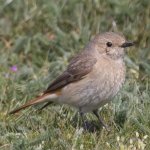Aladdin
Well-known member

Dear members and bird watchers
I took this picture of a bird thinking it was a Northern Wheatear just looking through the camera. And I have taken many pictures during my stay in Sweden and today I had a look at the picture on my computer.
For sure, it is not a Northern Wheatear. Anyone that can be so kind to tell me what kind of bird it is? After having opened in my computer I have identified it as a female common redstart, but I´m very doubtful.
Kind regards and happy birding
Aladdin
I took this picture of a bird thinking it was a Northern Wheatear just looking through the camera. And I have taken many pictures during my stay in Sweden and today I had a look at the picture on my computer.
For sure, it is not a Northern Wheatear. Anyone that can be so kind to tell me what kind of bird it is? After having opened in my computer I have identified it as a female common redstart, but I´m very doubtful.
Kind regards and happy birding
Aladdin






